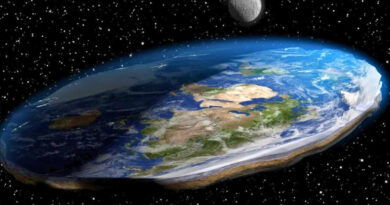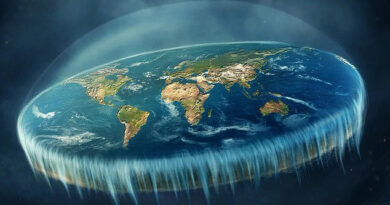Degrees of Sight On A Flat Earth
 Globe earthers will often quip that ‘if the earth were flat, then we could see all over it!’ but this is, of course, ignorant and inaccurate. If you stand on the beach, a plain or prairie, you will find the horizon extends about three to six miles around you – depending on the weather and your eyesight. The range of the human eye, our field of vision is from 110 to 1 degree, and the smallest angle under which an object can still be seen is 1/60 of 1 degree, so that when an object is 3000 times its own diameter away from an observer, it will cease to be visible. So, for example, the farthest distance at which one can see a 1 inch diameter penny, is 3000 inches, or 250 feet. Therefore, if a ship’s hull is 10 feet above the water, it will disappear from the unaided eye at 3,000 times 10 feet, or 6 miles. This has nothing to do with the supposed ‘convexity’ or ‘curvature’ of the earth and everything to do with the common Law of Perspective.
Globe earthers will often quip that ‘if the earth were flat, then we could see all over it!’ but this is, of course, ignorant and inaccurate. If you stand on the beach, a plain or prairie, you will find the horizon extends about three to six miles around you – depending on the weather and your eyesight. The range of the human eye, our field of vision is from 110 to 1 degree, and the smallest angle under which an object can still be seen is 1/60 of 1 degree, so that when an object is 3000 times its own diameter away from an observer, it will cease to be visible. So, for example, the farthest distance at which one can see a 1 inch diameter penny, is 3000 inches, or 250 feet. Therefore, if a ship’s hull is 10 feet above the water, it will disappear from the unaided eye at 3,000 times 10 feet, or 6 miles. This has nothing to do with the supposed ‘convexity’ or ‘curvature’ of the earth and everything to do with the common Law of Perspective.
The horizon of an observer is distant or near according to the greatness or otherwise of his elevation above the surface of the supposed globe. If he stands 24 feet above sea level, he is said to be in the centre of a circle, which bounds his vision, the radius of which in any direction, on a clear day, is six miles. A local gentleman tells me that he has watched a boat-race in New Zealand, seeing the boats all the way out and home, the distance being 9 miles from where he was standing on the beach. I have seen the hull of a steamer with the naked eye at an elevation of not more than 24 feet, as a distance of 12 miles, and in taking observations along the South African coast, have sometimes had an horizon of at least 20 miles at an elevation of 20 feet only.
The distance of the horizon, or vanishing point, where the sky appears to touch the earth and sea, is determined, largely by the weather, and when that is clear, by the power of our visioin. This is proved by the fact that the telescope will increase the distance of the horizon very greatly, and bring objects into view which are entirely beyond the range of vision of the unaided eye. But, as no telescope can pierce a segment of water, the legitimate conclusion we are forced to arrive at, is that the surface of water is level, and that, therefore, the shape of the world cannot be globular, and on such a flat or level surface, the greater the elevation of the observer, the longer will his range of vision be, and thus the father he can see. Thomas Winship, “Zetetic Cosmogeny
On the shore near Waterloo, a few miles to the north of Liverpool, a good telescope was fixed, at an elevation of 6 feet above the water. It was directed to a large seamer, just leaving the River Mersey, and sailing out to Dublin.
Gradually the mast-head of the receding vessel came nearer to the horizon, until, at length, after more than four hours had elapsed, it disappeared. The ordinary rate of sailing of the Dublin steamers was fully eight miles an hour; so that the vessel would be, at least, thirty-two miles distant when the mast-head came to the horizon. This 6 feet of elevation of the telescope would require three miles to be deducted for convexity, which would leave 29 miles, the square of which, multiplied by 8 inches, gives 560 feet; deducting 80 feet for the height of the main-mast, and we find that, according to the doctrine of rotundity, the mast-head of the outward bound steamer should have been 480 feet below the horizon.
Many other experiments of this kind have been made upon sea-going steamers, and always with results entirely incompatible with the theory that the earth is a globe. Dr. Samuel Rowbotham, ‘Zetetic Astronomy, Earht Not a Globe!’
*** This article has been archived for your research. The original version from Christian Flat Earth Ministry can be found here ***


